Flowers going up and coming down
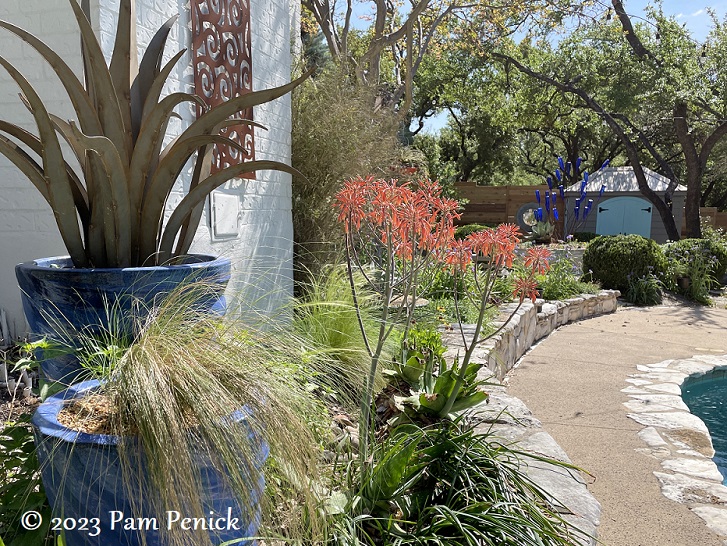
The first hummingbird appeared last weekend, zooming under the dangling red flowers of soap aloes. No surprise there. Those aloes put out quite the welcome mat for hummers.
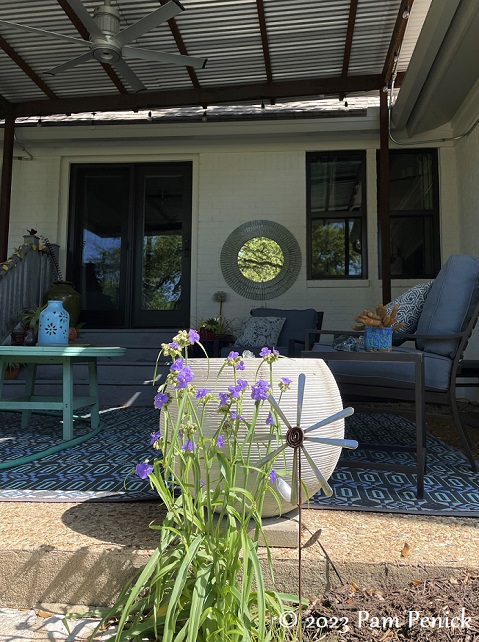
The spiderwort has had a good run — here’s a volunteer by the covered porch, looking pretty — but the mild days of spring are rapidly drawing to an end. We’ve already had a 90-degree day or two, and more are expected today and tomorrow. That means ratty, gone-to-seed spiderwort, so I’ll be getting out the pruners and cutting them down this week.
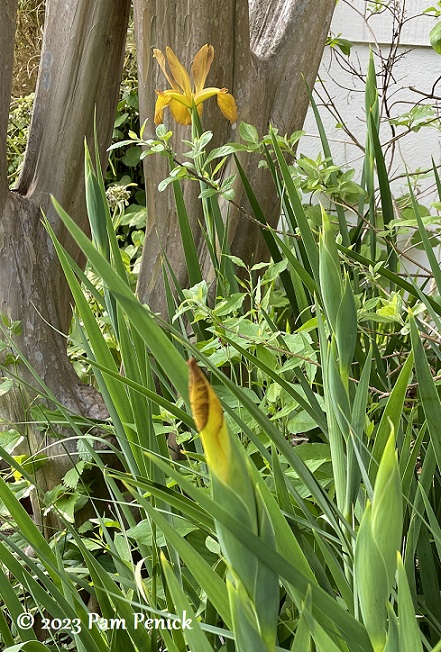
Spuria iris are starting to flower, and according to my records, they’re about a month early. Wow!

I gave the ‘Winter Gem’ boxwoods a haircut last week with my battery-powered hedge trimmers. I’ve learned a new trick for doing this chore: spread a couple of old sheets around the base of the shrub before trimming. Afterward, gather the trimmed leaves in the sheets and dump them into the yard waste bin. No more yellowing leaves scattered on the ground!
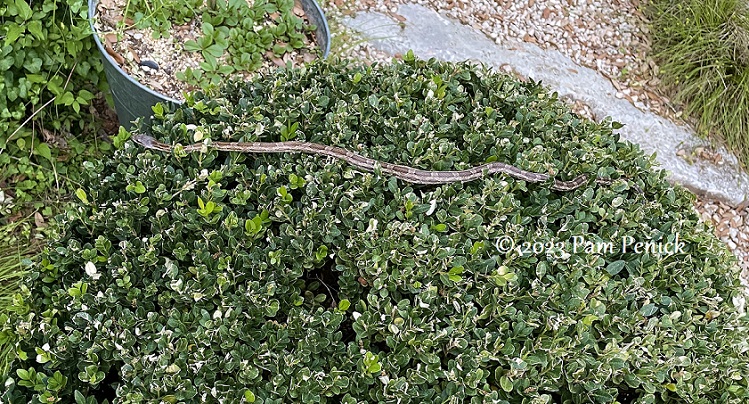
The next day, as I reached across a boxwood to pluck a missed leaf, I sucked in my breath and yanked back my hand — that involuntary “zero at the bone” reaction. It was just a harmless rat snake stretched across the boxwood ball, resting there. I suspect it was hunting birds. A pair of titmice are raising chicks in the owl box on the deck post high above. I hope they stay safe, but I didn’t intervene.

I did intervene on something else. Last week I noticed a change in the leaf pattern at the top of the big Yucca rostrata. Was it going to bloom after all these years, I wondered?
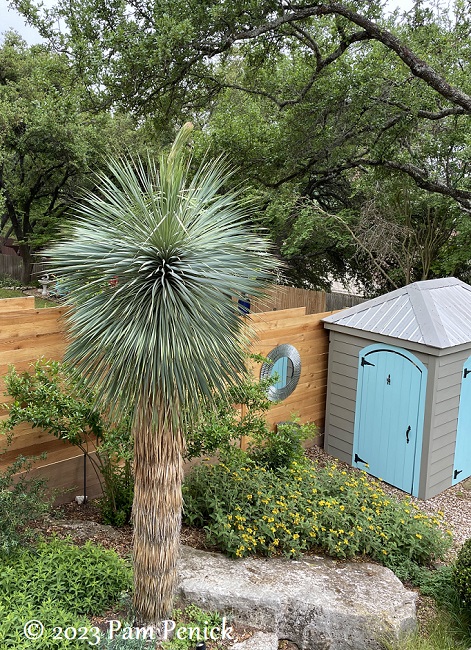
Sure enough, a view from the deck revealed a bloom spike rising from the top. An exciting moment, especially because yuccas, unlike agaves, don’t die after they flower. But then I remembered that I treat my big, valuable yuccas and agaves annually with a systemic drench to keep them safe from the agave snout-nosed weevil. Systemic insecticides are taken up by the roots and stay in the system of a plant for a year. That means that when the flowers open and pollinators like bees or moths find them, they would be poisoned. That’s a big nope. So I used a pole saw to cut off the bloom spike.
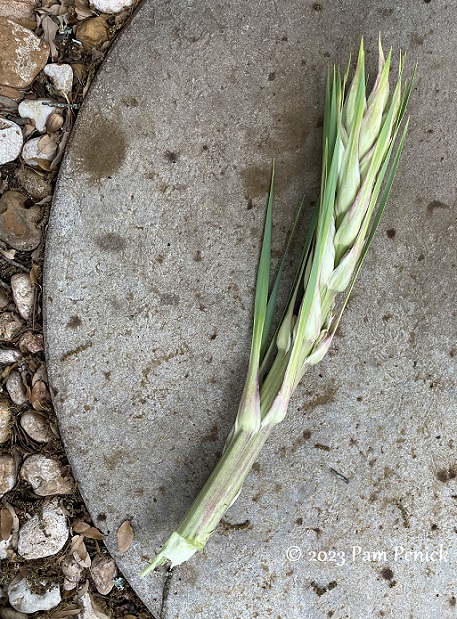
I’m sorry not to be able to enjoy the drama and beauty of the yucca’s flowering. But I would feel terrible about harming pollinators that were drawn to it. Removing it was the responsible thing to do.
I’m unwilling to take a chance on losing my big yuccas and agaves to the weevil, so I treat them — carefully and slowly, avoiding runoff onto other plants. And then I must take care not to let them flower. That way, only pests that chew into the plants are affected.
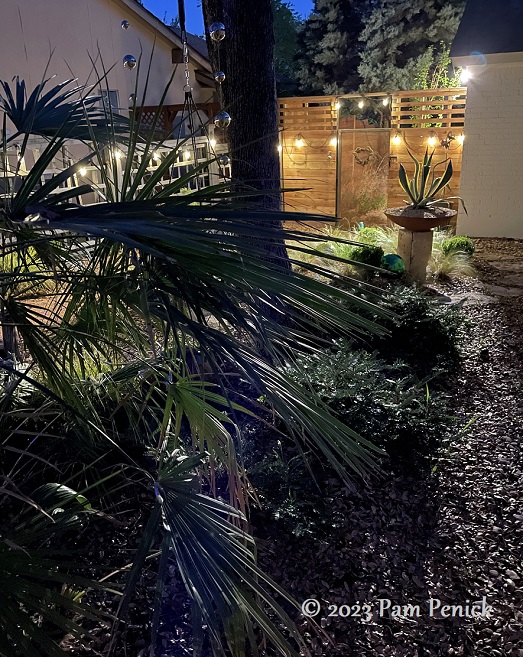
In the night garden, palm fronds add fringey silhouettes…
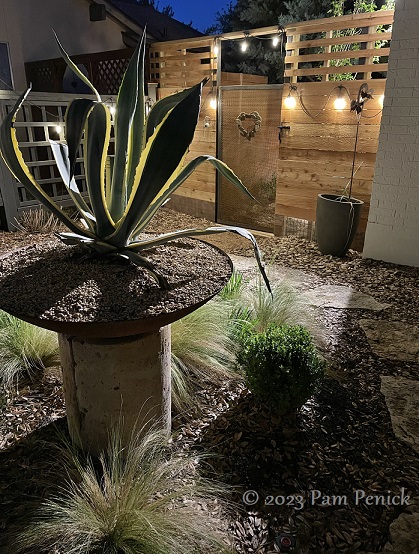
…and an ‘Opal’ agave’s yellow stripes glow.
I welcome your comments. Please scroll to the end of this post to leave one. If you’re reading in an email, click here to visit Digging and find the comment box at the end of each post. And hey, did someone forward this email to you, and you want to subscribe? Click here to get Digging delivered directly to your inbox!
__________________________
Digging Deeper
Shop for native Texas plants at the Wildflower Center’s spring Native Plant Sale. Held on Fridays through Sundays, March 24 to May 7, from 9 am to 1 pm. The first weekend is just for Wildflower Center members, so join to enjoy this perk, plus get free admission all year and more.
Experience the Surreal Garden at Zilker Botanical Garden, an enchanting neon-art display throughout the gardens, with food and drink, music and dancing, surreal performers, and interactive art sculptures. Surreal costumes encouraged! 25% of event proceeds benefit the Zilker Botanical Garden Conservancy. Runs April 6 (VIP Night), April 7-8, and April 13-15, from 6:30 pm to 11 pm.
Add to your succulent collection at the Austin Cactus & Succulent Society Spring Show & Sale on April 15 and 16, from 10 am to 5 pm, at Zilker Botanical Garden. Come enjoy the plant show, shop for unique plants and pottery, and participate in a silent auction and raffles. Free with paid admission to Zilker Botanical Garden.
Come learn about gardening and design at Garden Spark! I organize in-person talks by inspiring designers, landscape architects, authors, and gardeners a few times a year in Austin. These are limited-attendance events that sell out quickly, so join the Garden Spark email list to be notified in advance; simply click this link and ask to be added. Season 8 kicks off in fall 2024. Stay tuned for more info!
All material © 2025 by Pam Penick for Digging. Unauthorized reproduction prohibited.


Gorgeous – plants and snake alike! Thank you also for the reminder/tip about systemic insecticides and pollinators. I so rarely use systemics that I’d be prone to forgetting about subsequent bloom removal to protect pollinators.
Thanks, Shelley. I wanted to share so anyone relying on a systemic to protect their investment in a big agave or yucca would not make that mistake. I hope it helps.
Thanks for great tip on pruning with underlying sheets!! Love that idea!
Interested yucca treatment and good to know! I’ve dreamed of one but don’t think I’ll invest now after learning from your process! It would hurt to much to cut that bloom.
The sheet tip is so helpful. I wish I could remember where I saw it so I could credit them.
I saw that tip from Laura on Garden Answer/YouTube.
I always enjoy seeing what is going on in your garden.
Spiderwort makes itself at home here and there in my garden too.
My snake story was when I thought the kids left an old bicycle tire tube across a shrub and I started to pick it up fuming that they would do that, turned out to be a big black snake. Ha I nearly fainted. Not that I was scared just totally surprised. It was hangout near a bluebird box.
Your snake story is so similar to my own recent snake experience. Funny!
“involuntary “zero at the bone” reaction”…. what is meant by this phrase? I’ve not heard it before.
As for the yucca flowering and removal… wow. Good on you for keeping the pollinators from being poisoned, but that must have been hard to do, no?
Yes, it was hard to remove the flower. I would have loved to see it bloom. But it’s worth the sacrifice to keep pollinators safe while also protecting the major woody lilies in my garden from the agave weevil. I have friends who’ve lost big rostratas to the weevil.
The quote is from one of my favorite Emily Dickinson poems, “A Narrow Fellow in the Grass”:
A narrow Fellow in the Grass
Occasionally rides –
You may have met him? Did you not
His notice instant is –
The Grass divides as with a Comb,
A spotted Shaft is seen,
And then it closes at your Feet
And opens further on –
He likes a Boggy Acre –
A Floor too cool for Corn –
But when a Boy and Barefoot
I more than once at Noon
Have passed I thought a Whip Lash
Unbraiding in the Sun
When stooping to secure it
It wrinkled And was gone –
Several of Nature’s People
I know, and they know me
I feel for them a transport
Of Cordiality
But never met this Fellow
Attended or alone
Without a tighter Breathing
And Zero at the Bone.
Thank you!
That iris is just so gorgeous, Pam. Spiderwort is a real invasive in my garden and I’m working on getting rid of it, a little at a time, despite its beauty.
Whoa! That snake was a surprise; glad he’s harmless (to humans anyway).
I’m proud of you for whacking the flower stalk off the yucca. That must’ve been painful.
Today I noticed another one about to flower. Time to get the pole saw out again. 🙁
Your yard is looking so nice! And, wow, I have never heard of that weevil. I hardly ever see yuccas in Houston, but I do occasionally see agaves. Maybe that’s why, huh! The Big Bad here seems to be the Squash Vine Borer.
I’m glad the cold weather is over, but, of course, not looking forward to months of heat and humidity. But that’s the weather! Take what you get. Hopefully, we will have decent rains (not hurricanes or tropical systems, please) this summer. In the meanwhile, I’m enjoying what is left of Spring!
I’m hopeful for a gentle summer as well. We’ve earned it! 🙂